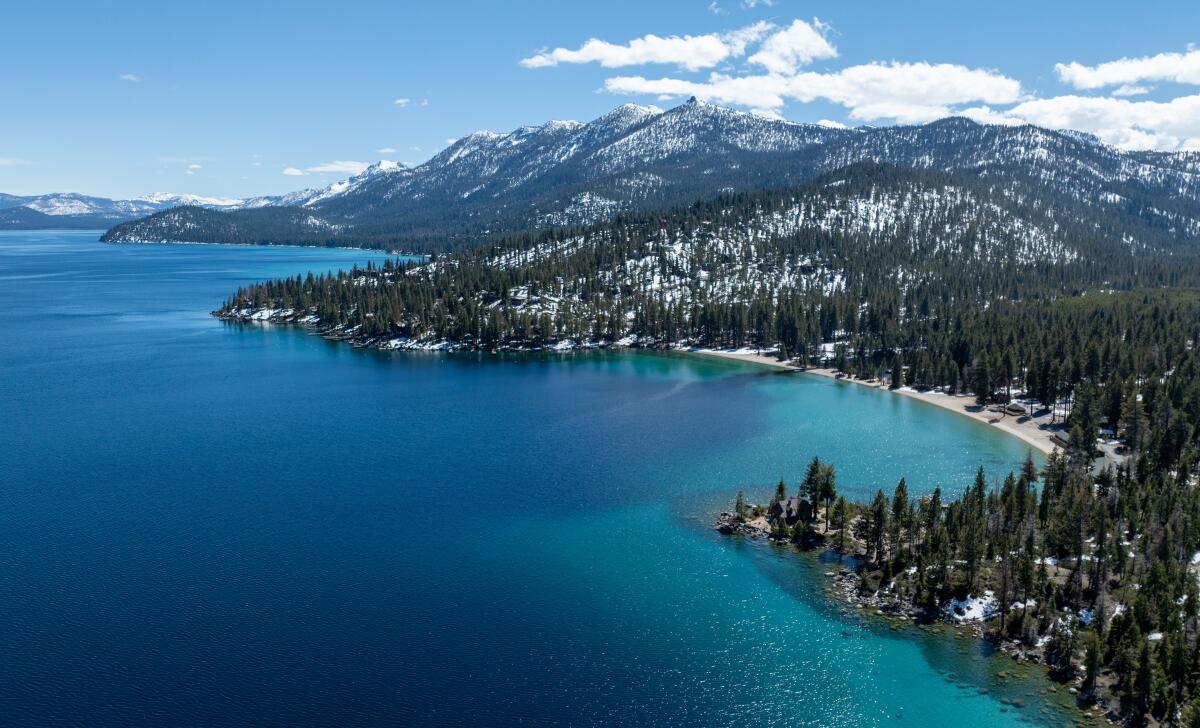California’s snowpack report card is in. What does it mean for the water supply?

- Share via
Good morning. Here’s what you need to know to start your day.
- California’s snowpack report card is in. What’s it mean for the water supply?
- Nearly three months after L.A.-area fires, the 30th victim was discovered in Altadena ruins.
- Fifteen L.A. restaurants where ordering the house specialty is a must.
- And here’s today’s e-newspaper.
Our snowpack report card is in. This one is going on California’s fridge
Some measure the year by calendar, by birth dates or by tax returns. For California water managers, the key date is April 1. That’s when researchers push their trusty tubes down into the snow covering the Sierra Nevada to see how much has accumulated just as the wet season typically peaks.
How’d we do this water year?
After a dry start, the mountains are sitting pretty with a near-average 96% snowpack, my colleague Ian James reported. That’s a trifecta that hasn’t happened since Bill Clinton was president.

“As of Tuesday, the snowpack measured 118% of average in the northern Sierra Nevada, 91% of average in the central Sierra and 84% of average in the southern Sierra,” Ian noted.
That sets the Golden State up for a third straight year of ample water supplies in the mountains after three years of historic drought. Our snowpack typically provides almost a third of California’s water supply.
The snowpack isn’t the full story
Northern California saw more snow and wetter conditions that helped push statewide precipitation to 103% of average for this time of year.
But it was a different story in Southern California, where a lack of rainfall early in the storm season dried out the region, and later storms didn’t help much.
The vast majority of coastal counties from Santa Barbara to San Diego are experiencing “severe drought” conditions, according to the U.S. Drought Monitor’s latest reporting. Looking inland, swaths of San Bernardino, Riverside and Imperial counties are in “extreme drought,” data show.

What does this mean for California’s water supply?
In the short term, more is being allotted to farms and communities in Central and Southern California. Major state reservoirs have reached 117% of average levels thanks to the back-to-back-to-back wet years.
Despite the Southland’s dry turn, the Metropolitan Water District of Southern California reports a record amount of water banked in reservoirs and underground storage areas. That water gets delivered to roughly 19-million people in six counties.
“The latest storms and increased snowpack prompted state water officials last week to increase their forecast of water deliveries this year from the aqueducts of the State Water Project,” Ian explained. “The Trump administration also announced last week that it increased water allocations this year for the Central Valley Project … the federally managed system of dams and reservoirs that delivers supplies from the Delta to farmlands and communities in the San Joaquin Valley.”
Please note: We’re not so much out of drought as between droughts
That’s the perspective water experts emphasize: the next dry spell could be on tap and we should act accordingly.
“We need to be accelerating and expanding conservation and efficiency policies,” hydroclimatologist Peter Gleick told me two Aprils ago. “It’s precisely in the wet years, when we have a little breathing room, that we ought to be doing more to prepare for the dry years that we know are increasingly frequent.”
And the pendulum swing between wet and dry is getting more volatile, which human-caused climate change is augmenting, experts say.
“Scientific research has shown that droughts are growing more intense in the western United States because of global warming and that average snow lines have been creeping higher in the mountains as temperatures rise, altering runoff patterns,” Ian noted.
You can read more reporting from Ian on California’s snowpack trifecta.
Today’s top stories

How Trump’s fight with California could harm poor students who rely on school meals
- Federal aid to feed poor children at school could be joining the long list of funding at risk if California officials don’t abide by Trump administration policies and edicts.
- California receives more than $3 billion annually in federal aid to feed children in school.
Immune amnesia: Why even mild measles infections can lead to serious disease later
- A mild case of measles destroys the memory cells that confer resistance on bugs the patient has previously fought, in what doctors call “immune amnesia.”
- A measles outbreak has infected nearly 500 people in 19 states, including California. Vaccinations prevent both the measles and the subsequent loss of immune protections.
Nearly three months after L.A.-area fires, the 30th victim was discovered in Altadena ruins
- The recently discovered victim, found on a block of Boston Street that intersects with Altadena’s main commercial thoroughfare, Lake Avenue, appears to be the first death from the Eaton fire east of Lake Avenue.
- Until now, all of the deaths from the Eaton fire occurred west of Lake Avenue, where residents did not receive an evacuation order until around 3:30 a.m. Jan. 8.
What else is going on
- Do you live in a wildfire hazard zone? Here’s what that means.
- Even in O.C. Trump country, some worry about how tariffs will hit their pocketbooks.
- Schools have 10 days to comply with Trump anti-DEI policy or face losing federal funds.
- A rising SoCal culinary star dies in a freak Hawaii hiking accident, hit by tumbling boulder.
- L.A. housing authority is turning a luxury Woodland Hills apartments into affordable housing.
- Shohei Ohtani MVP bobbleheads were free at Dodger Stadium. Now they cost up to $1,450 online.
- In O.C., former Vice President Harris says she’ll stay politically active: ‘I’m not going anywhere.’
- A nursing influencer and wife of an L.A. firefighter dies after giving birth to their son.
- While Val Kilmer’s family asks to mourn privately, Tom Cruise makes his grief public.
Get unlimited access to the Los Angeles Times. Subscribe here.
Commentary and opinions
- Another painful crisis has us asking: Can Los Angeles accomplish big things again? columnist Patt Morrison writes.
- The Trump administration is trying to force a deal on Ukraine and President Volodymyr Zelensky that would make the imperialists of the past blush, writes columnist Jackie Calmes.
- The Dodgers should meet with Trump. In No. 42 Jackie Robinson jerseys, columnist Gustavo Arellano writes.
- At Leisure World, they’re up in arms, crying ‘hands off’ their Social Security, writes columnist Steve Lopez.
- Of course Sundance is fleeing. Utah has become a hateful place, guest columnist ML Cavanaugh writes.
This morning’s must reads

Black L.A. social spaces flourished after George Floyd. Five years later, will they survive? Black Image Center in Mid-City is the latest of several Black small businesses to close in Greater Los Angeles. The closure of Black Image Center’s physical space echoes that of other small businesses in the area that have served as Black community hubs beyond their primary offerings, with many owners saying the initial support garnered during the height of the Black Lives Matter movement has since waned.
Other must reads
- For many Palisades residents, Traci Park is the face of the fire recovery.
- ‘Who do I need to talk to or bribe to be a part of this?’ Laurence Fishburne looks back on 12 key roles.
How can we make this newsletter more useful? Send comments to essentialcalifornia@latimes.com.
For your downtime

Going out
- 🥙 Fifteen L.A. restaurants where ordering the house specialty is a must.
- 🥾 Three L.A. hikes to embrace the start of spring.
Staying in
- 📺 Checkout time is nearly here for “The White Lotus” Season 3. Ahead of the season finale Sunday, tell us your finale theories.
- 😋 Here’s a recipe for passion fruit-poppy seed muffins.
- ✏️ Get our free daily crossword puzzle, sudoku, word search and arcade games.
A question for you: What’s your favorite thing to do during spring in California?
Email us at essentialcalifornia@latimes.com, and your response might appear in the newsletter this week.
And finally ... your photo of the day
Show us your favorite place in California! Send us photos you have taken of spots in California that are special — natural or human-made — and tell us why they’re important to you.

Today’s great photo is from Times photographer Robert Gauthier at the Wednesday night Dodgers game against the Braves at Dodger Stadium.
Have a great day, from the Essential California team
Ryan Fonseca, reporter
Andrew Campa, Sunday reporter
Kevinisha Walker, multiplatform editor
Hunter Clauss, multiplatform editor
Christian Orozco, assistant editor
Karim Doumar, head of newsletters
Check our top stories, topics and the latest articles on latimes.com.




